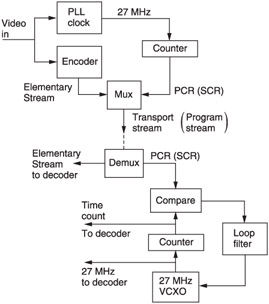3.23 Program Clock Reference
| | ||
| | ||
| | ||
3.23 Program Clock Reference
A transport stream is a multiplex of several TV programs and these may have originated from widely different locations. It is impractical to expect all the programs in a transport stream to be genlocked and so the stream is designed from the outset to allow unlocked programs. A decoder running from a transport stream has to genlock to the encoder and the transport stream has to have a mechanism to allow this to be done independently for each program. The synchronizing mechanism is called program clock reference (PCR).
Figure 3.46 shows how the PCR system works. The goal is to re-create at the decoder a 27 MHz clock synchronous with that at the encoder. The encoder clock drives a 48-bit counter that continuously counts up to the maximum value before overflowing and beginning again.

Figure 3.46: Program or system clock reference codes regenerate a clock at the decoder. See text for details.
A transport stream multiplexer will periodically sample the counter and place the state of the count in an extended packet header as a PCR (see Figure 3.45). The demultiplexer selects only the PIDs of the required program, and it will extract the PCRs from the packets in which they were inserted.
The PCR codes are used to control a numerically locked loop (NLL). The NLL contains a 27 MHz VCXO (voltage controlled crystal oscillator), a variable-frequency oscillator based on a crystal having a relatively small frequency range.
The VCXO drives a 48-bit counter in the same way as in the encoder. The state of the counter is compared with the contents of the PCR and the difference is used to modify the VCXO frequency. When the loop reaches lock, the decoder counter would arrive at the same value as is contained in the PCR and no change in the VCXO would then occur. In practice the transport stream packets will suffer from transmission jitter and this will create phase noise in the loop. This is removed by loop filter so that the VCXO effectively averages a large number of phase errors.
A heavily damped loop will reject jitter well, but will take a long time to lock. Lockup time can be reduced when switching to a new program if the decoder counter is jammed to the value of the first PCR received in the new program. The loop filter may also have its time constants shortened during lockup. Once a synchronous 27 MHz clock is available at the decoder, this can be divided to provide the 90 kHz clock frequency that drives the time stamp mechanism.
The entire timebase stability of the decoder is no better than the stability of the clock derived from PCR. MPEG-2 sets standards for the maximum amount of jitter present in PCRs in a real transport stream.
Clearly, if the 27 MHz clock in the receiver is locked to one encoder it can only receive elementary streams encoded with that clock. If it is attempted to decode, for example, an audio stream generated from a different clock, the result will be periodic buffer overflows or underflows in the decoder. Thus MPEG defines a program in a manner that relates to timing. A program is a set of elementary streams encoded with the same master clock.
| | ||
| | ||
| | ||
EAN: 2147483647
Pages: 120